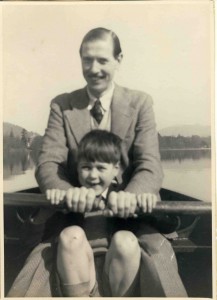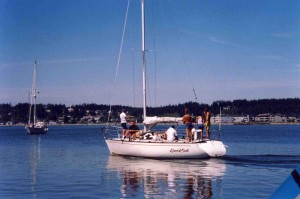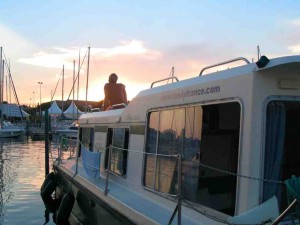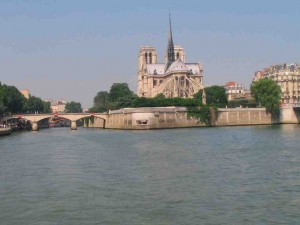Waterways have always attracted me. One of my earliest pre-school memories is fishing for tadpoles in the creek across the road from our home in Cambridge, England, where I lived for my first 18 years. My recall is particularly vivid because Mum had forbidden me to play in the stream and caught me much too often wading into the water. Dad, on the other hand, introduced me at an early age to the joys of rowing, swimming, canoeing and sailing in more legitimate but not always less risky waters. Body, board and canoe surfing on the waves along the Cornish coast during school holidays still bring back exhilarating memories of careening into the beach and scary flashbacks of near drowning. More than a decade of school, club and college rowing raised lifelong callouses on my hands from thousands of river training miles and a legacy of unforgettable peak experiences of races won. In Wisconsin I was introduced to lake sailing but always regretted never trying ice yachting during our two frigid winters there as grad students. Living in Vancouver, I sailed Lasers out of Jericho for more than two decades; although Plu seldom wanted to join me, our daughter, Zosia, occasionally would take the risk. Plu always preferred the pleasures on the beach. But then in 2001, while on holiday in Maui, Plu suddenly decided to join me sailing aboard America II, the America’s Cup challenger skippered by Dennis Connor off Freemantle, Australia in 1987. Despite having always been a weak swimmer and being somewhat afraid of the water, she was amazed to discover she loved the thrilling experience. Since that day our lives have never been the same, as we recount in the following paragraphs, providing links to greater details and photographs of our voyages (also see other page listings under Waterway Cruiser in navigation top right above).
From Day Trippers to Owners
Before leaving Maui, we went out on another sailboat, a 36′ cruiser, to test the waters further and Plu even enjoyed the rush of reaching in the trade winds blasting across Maalaea Bay. On returning to Vancouver we decided to take some lessons to build up our confidence and skills together. The course offered by Cooper Yachts on Granville Island was an excellent mix of one night a week in the classroom and one day of the weekend on the water for three weeks followed by the exam for the Canadian Yachting Association Basic Cruising Certification. We thought our next gradual step should be to rent boats to get more experience. But our daughter soon introduced us to a friend, Kevin, who was an avid sailor and looking for a boat that he could race with a crew of young mates. Within a couple more months we were the proud owners of a Santana 30/30, called Knockout. Built in the 1980s, she had seen better days but had been used for racing in the Seattle area, where we found her. We were exceedingly fortunate to find moorage for her at the False Creek Harbour Authority’s wharves in Vancouver, just across the road from where we live in the Pennyfarthing condos on Creekside.
From Cruising to Racing
During the next two years, Kevin refurbished Knockout for racing and showed us how to take her cruising. But even more magnificent was the introduction he gave us to the joys of racing, beginning with the Wednesday night schedule in English Bay. Knockout was designed to be raced with a crew of six or seven. When we were on board for races the other members of the crew were mostly young people with a great deal more sailing experience than Plu and I. Watching them was a great way to learn. But nothing beats racing as a way to learn fast. From the chaotic manoeuvring of the first start that we experienced on board, Plu and I were totally hooked on the thrills and excitement of flying water and screaming participants. For the big regattas, Kevin would assemble the best crew he could find and tried to keep them together for the season. On these occasions Plu and I would help in ferrying the boat to the place of the regatta and then cheer them on from the shore. At the biggest event of the summer, Whidbey Island Race Week in the US San Juan Islands, we were bowled over when Kevin and his crew came first in their division in the first year competing. The following year they finished third in the division. We were extraordinarily proud and pleased with these successes.
From Knockout to Carpe Diem
But by the end of two years, much as we thrilled to the racing, we realized that Knockout was not the right boat for the cruising that Plu and I wanted to do. In between the races, we thoroughly enjoyed sailing in the Gulf Islands and San Juans with just the two of us aboard. But we also found that the boat was not well designed for two people to sail when the winds blew up strongly and storms broke upon us; at these times it was too much boat for us to handle safely. At the same time, even though we had greatly improved the accommodations, we concluded that it was not suitable for living aboard for weeks at a stretch, particularly if we moored out away from the facilities at marinas. We began to look more closely at larger sailboats designed for coastal cruising and in the fall were seduced into placing an order for a new Catalina 320 and somewhat sadly, sold Knockout knowing that we would no longer be racing. Our new boat, which we christened Carpe Diem, arrived from the manufacturer in California just in time for the Vancouver Boat Show in February 2004, where it was shown by the local Catalina agent in exchange for a generous discount on our purchase price.
The Joys of Carpe Diem
During the next two years we had a magnificent time cruising in nearby coastal waters. In the summer of 2004 we explored the Gulf Islands. The Christmas of that year we spent aboard at Bowen Island and cruising in Howe Sound. The following summer we sailed down into the US waters and toured around the San Juan Islands. Mooring Carpe Diem at False Creek Harbour Authority enabled us to be aboard and sailing in English Bay within 30 minutes from leaving our condo. This meant we could go for a sail any time the conditions looked good in English Bay and we had three hours we would take off. On weekends we would often go down to her even if we did not plan to leave the dock. As soon as we were on board we felt we had entered another world; it was and continues to be an extraordinary feeling of escape, from which we never fail to return refreshed. Having friends join us aboard for a sail and dinner has added immense pleasure to our entertaining.
Cruising the Canal du Midi
Then in the summer of 2006 we decided to add a little variety to our cruising and celebrate the end of my seven-year term as Director of SCARP by renting a boat on the Canal du Midi for the month of July. This had been a gleam in our eyes for many years but suddenly it became a much more feasible venture after I stumbled upon a self-published guide book by a California couple who had been cruising the Midi for many years. Following their advice we rented the cheapest and smallest boat we could find, an old Eau Claire 930 from Rive de France. We picked it up in Colombiers and headed east with the goal of getting to the junction with the Rhone near to Avignon. But we never got that far as we soon were drawn into the slow pace of canal cruising and began exploring the many attractions of the villages and their markets and their wineries and restaurants. In the midst of our cruising we discovered a particularly attractive village, Meze, and stayed moored in its harbour on the Etang du Thau for 10 days.
It was during this time that we began to ruminate about wild possibilities for the following year when I would be on Administrative Leave following my time as Director. What if we bought one of the old houses in the village and renovated it for future holidays and our retirement? We looked at a number of old houses that were for sale but those that were reasonably priced needed lots of work and talking with others who had done this we found the challenges somewhat daunting. What if we bought an old canal boat like the one we had rented? The prices seemed reasonable and a boat would give us the advantage of being able to move around the canals and stay in places as long as we liked. The possibilities for cruising seemed endless looking at the canal networks and interconnected rivers of Europe (this is a flash file; click on the zoom to focus in more detail on waterways linking from the UK in the northwest to the Black Sea in the southeast and beyond). But to do this and to live aboard outside of summer months would require a more substantial boat in terms of size, engines and living accommodations. And then one day a type of boat we had not previously seen moored besides us in Meze – a Dutch steel canal kruiser. It was owned by a retired couple from New Zealand, who came over for the northern hemisphere summer each year and cruised a part of the European waterways they had not previously visited. Over the years they had traveled north through France, into Belgium and on to Holland, and had spent time in Germany. After visiting them on their boat and talking with them about their experiences, Plu and I were seriously interested in the apparent possibilities.
The Dreaming Gets Serious
Returning to Vancouver, we immediately began searching on the web to find more information about the kind of Dutch boat we had seen and cruising the canals and waterways of Europe. It did not take long to find out that there were substantial numbers of people who had done much like what the New Zealanders had described to us. There were some who had created web sites where they recorded their experiences in buying boats and living and traveling aboard them, venturing all over the European canals and waterways and even further abroad crossing the Channel to the UK and following the Danube and other waterways east into central Europe. There were a number of web sites and listservs where boaters were exchanging information and responding to queries from neophytes like ourselves. Everything we learned only encouraged us to find out more. One of the frequently recurring recommendations was to focus on buying a boat in Holland where there were many more for sale and boatyards long experienced in working on them. Further, the Dutch steel boats, like the one we had seen in Meze, were by far the most popular and frequently recommended type of vessel. While there were fibreglass boats being used they were much less popular outside of the rental fleets and, although the traditional old barges were hugely romantic to look at, the stories we read made clear that they were a much more ambitious and risky investment, particularly for first time buyers and inexperienced operators like ourselves. Our research thus focused on the Dutch steel cruisers and where they were for sale.
Going for Broke
In several places we ran across stories of a Dutch broker who had been very helpful to people from abroad who were buying used canal cruisers for the first time. We contacted him by email in later August and were delighted when he agreed to help us learn more about what was available for sale in our price range. Pictures and details on vessels for sale in various parts of Holland began flowing in by daily email and we started to get more and more excited about the possibilities. After about three weeks, the broker told us that the only way to progress beyond the general impressions we had developed about options was to come to Holland and look at potential boats up close; he cautioned that looking at photographs and reading specifications did not tell you what you needed to know to determine whether any one of them is a real contender. After some reflection, we agreed and decided to go and test the waters for real.
At the end of September we arrived in Rotterdam on a Sunday with an agreement that we would spend 10 days looking at boats and seeing if we could find one that we would buy. So that we could inspect boats available all over Holland and to not waste time trying to locate where they were moored, we hired the broker to drive us to them. This strategy also had the major advantage of being able to have his comments and advice on all the boats we went aboard. By the end of Monday we had visited enough boats to realize that our budget was too low to be able to buy a boat of the size and minimum conditions we wanted. In brief, we hoped to find a boat big enough and suitably equipped to live on and cruise year round and to be in good enough condition that we could board it before Christmas and be ready to go cruising. Over dinner we agreed on a larger budget and the broker spent most of the night contacting colleagues to find boats that might fit. By the end of the next day we knew we were shopping in the right price range and had seen one possible candidate. The following day in northern Holland we saw the boat we eventually decided to buy.
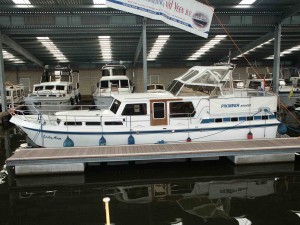
Our first choice is found afloat in a wintering shed in Terherne, Northern Holland but the name must change
By Friday night we had been on board 32 boats and seen even more that we decided to not waste time going aboard. Our search had reached out to all four points of the compass in Holland and we had visited a couple more that sounded good down in Belgium. Over dinner that night we agreed on the negotiating strategy the broker would employ with the owner of our preferred choice. If this didn’t work we would go on to the second preference. By Sunday night, we had agreed to buy our first choice at a price a little over what we had originally set as our ceiling, subject to an independent survey and sea trial. Monday we signed papers and made a down payment. Tuesday we returned to Vancouver. A month later the sale was complete and we had renamed our boat Tempus Fugit. In the first week of December we flew into Schiphol with four canvas bags and Plu’s sewing machine where we were met by our broker, who took us to Tempus Fugit to sleep aboard for the first time. Over the four short but intense months we had worked with our broker, we had developed an exceptionally high regard for his expertise and professionalism and we had formed a deep friendship that thrives still today. Without him nothing of what follows would ever have been possible.
The Tempus Fugit Years
We spent the next four months living aboard Tempus Fugit, moored in a marina at Kudelstaart just outside Amsterdam, decompressing from the extraordinary pressures of the last six months and slowly beginning to climb up an entirely new learning curve. In retrospect it was a remarkable time of rebirth in spirits, energy and outlook, which you can read about elsewhere in detail. Eventually in April, bathed in magnificent spring sunshine, we cast off from our comfortable moorings and left behind the many friends and joys we had discovered during our stay in Kudelstaart and Amsterdam. We crossed the lake, went out under the first road bridge that was lifted for us while all the traffic on a four lane highway was stopped and began a trip that took us east across Holland to Maastricht and over the border into Belgium. From there we traveled back west across Belgium before turning south into France. On a memorable day in early May, in brilliant sunshine we came up the Seine into Paris, where we moored for the next five weeks in the heart of the city and discovered some of its remarkable splendours.
We then headed south through the centre of France, on a long, slow journey that eventually in early August brought us to Saint Jean de Losne, just south of Dijon. Saint Jean is renowned as the water crossroads of Europe – within a few kilometres 4 water routes conjoin: the Saone River, the Canal de Bourgogne, the Canal du Rhone au Rhin and the Canal entre Champagne et Bourgogne. In the four months we had been travelling from Amsterdam to Saint Jean we had covered 1448 kilometres, gone through 223 locks and passed under at least twice as many bridges. During the next three months we repaired the damage we had done to the boat as we learned the hard way how to navigate the challenges of waterways conveying huge barges and the locks that lift vessels up and down through as much as 73 metres.
In November this unprecedented year afloat ended. We closed down Tempus Fugit and returned to Vancouver. I began teaching again in January and Plu started to work on the quilts and watercolour paintings stimulated by all we had seen during our year’s journey. During the summers of 2008 and 2009, we came back to Saint Jean to spend time on the boat and explore the extraordinary watersheds and canals in this region of Burgundy. In between these times we continued to sail out of Vancouver on Carpe Diem during evenings and weekends of the spring and fall months. And we began to plan for how we might move to a two-continent, two-boat lifestyle with six months of the year on each, once I joined Plu in retirement.
Moving To The Med
[the story from here through today remains to be written BUT parts of it already exist as sub-pages that focus on planning for the trip south and on learning to maintain the boat once we arrived in Gruissan]
Planning to Go Down the Saone and Rhone, thru’ the Canal du Mid to Gruissan 2010
Planning to Cross from Cap d’Agde to Gruissan
